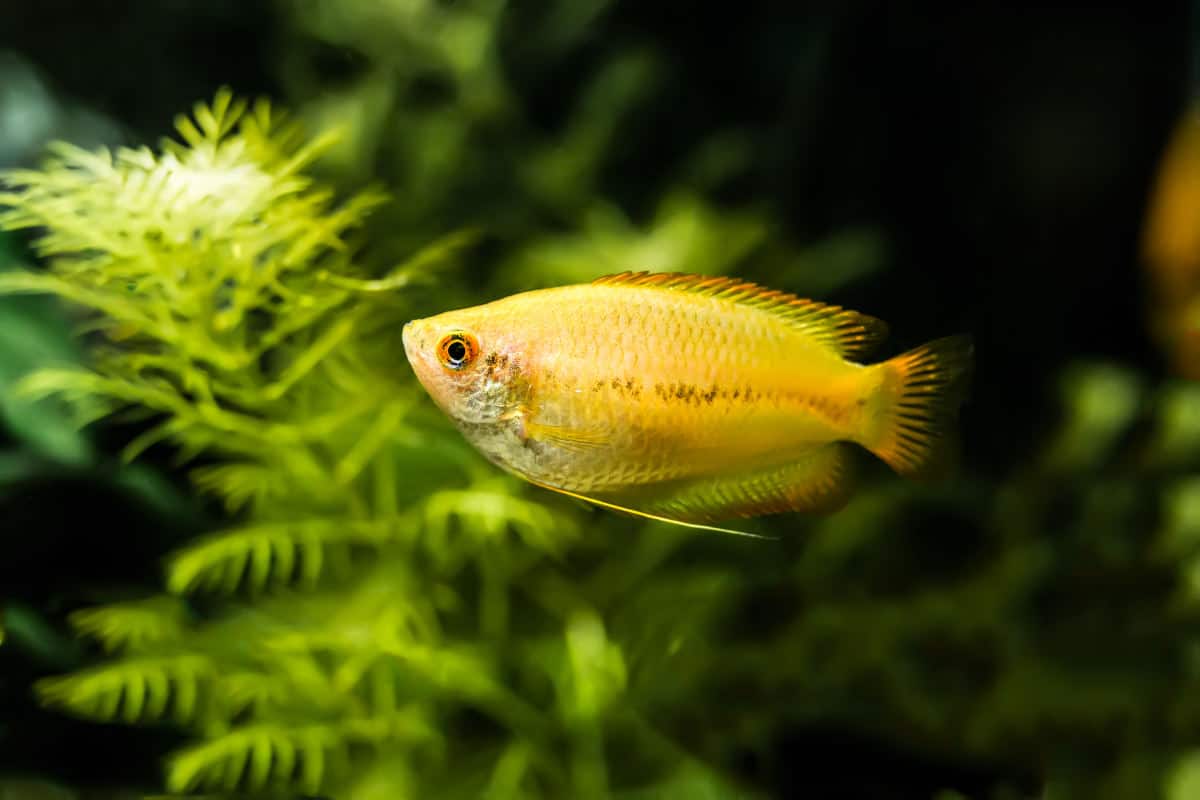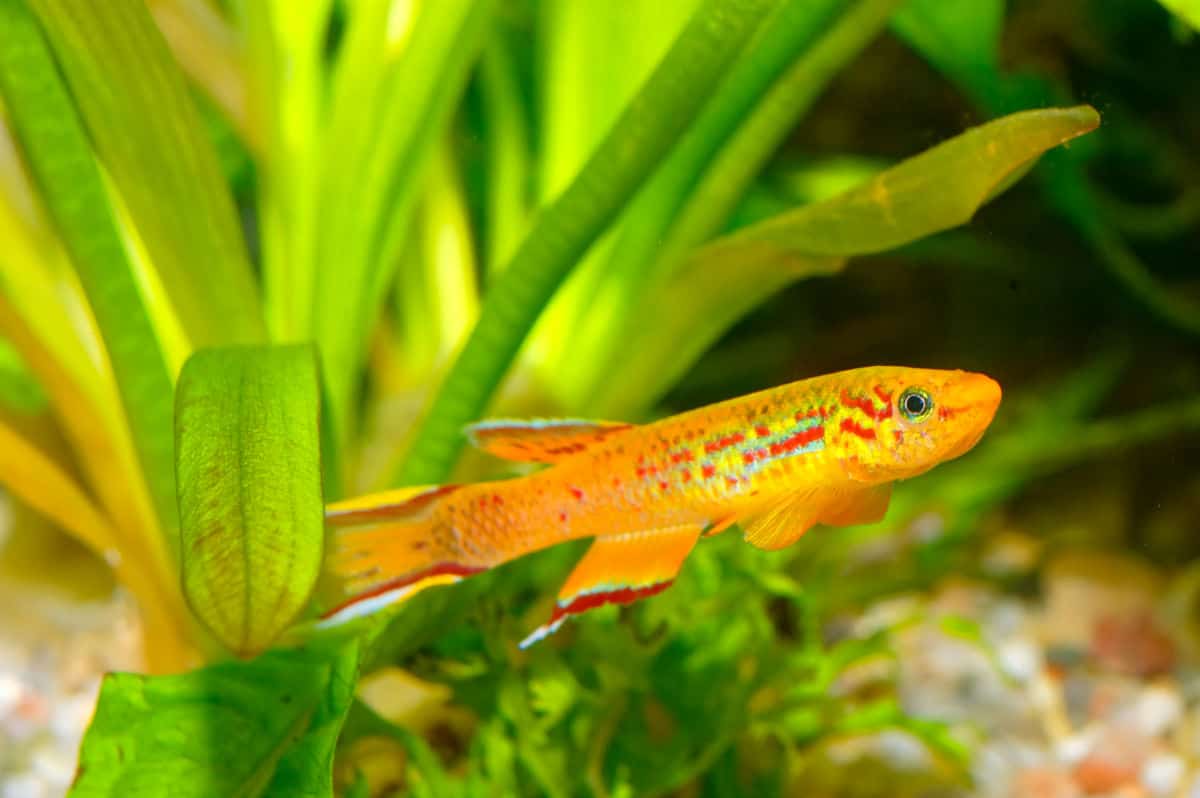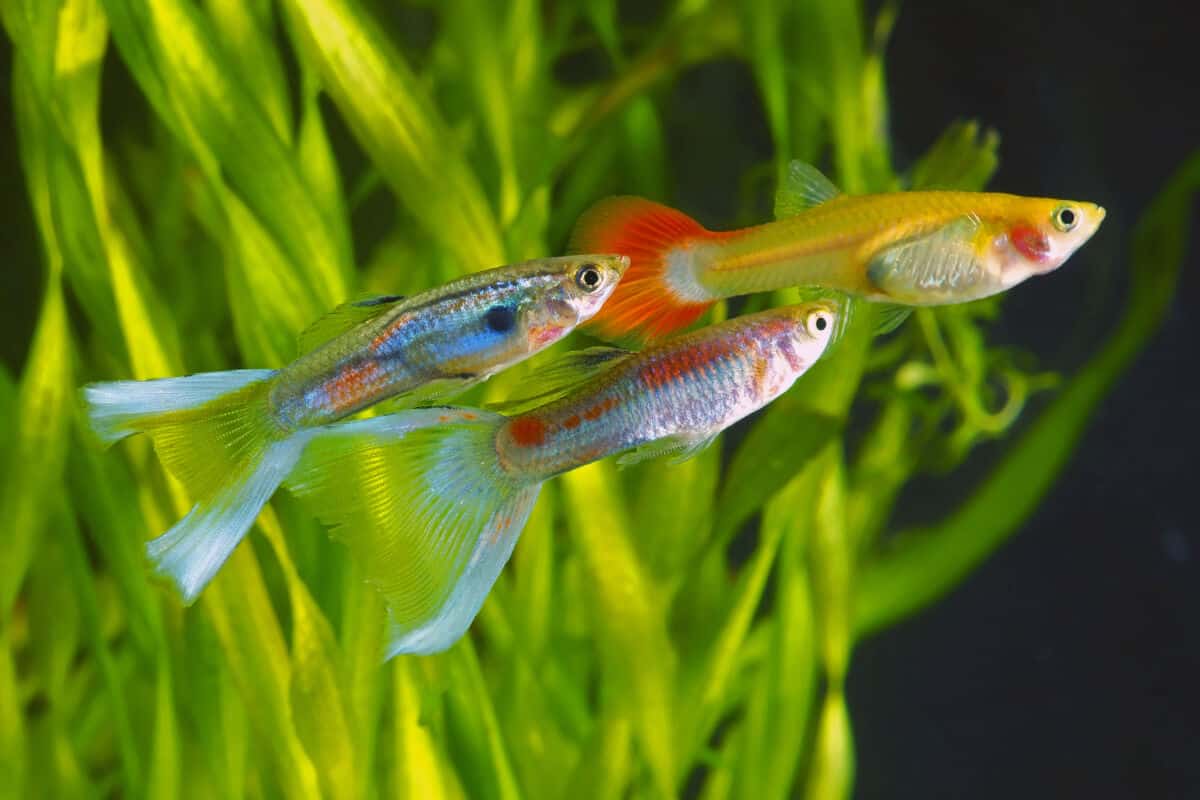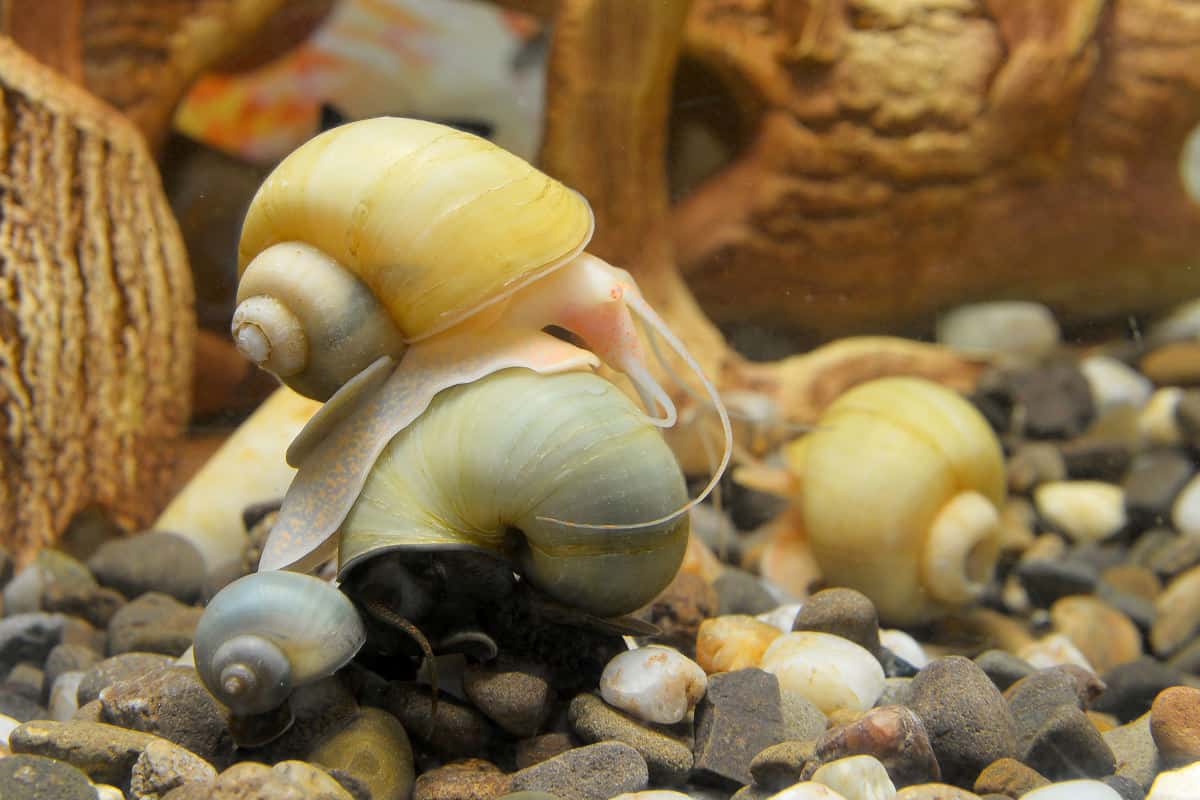The honey gourami has quickly become one of the most popular fish to keep as a pet. With their vibrant colors and friendly personalities, they are a great addition to a home aquarium.
They aren’t only colorful, but these beautiful freshwater fish are generally placid and get on well with smaller fish.
However, when considering adding a new breed to your tank, you must be sure you have carried out adequate research first. This is so you can be certain that your new fish will be matched to, happy and relaxed in its new environment.
In this article, we aim to tell you everything there is to know about honey gourami care, so you can be sure you’re doing everything you can to keep your new fish happy and healthy.
We will cover essential facts and statistics, as well as examine their appearance, behavior, natural habitat, and tank setup.
We will then look at what you should feed your honey gourami and how you can breed them, should you wish.
Honey Gourami Overview & Statistics
Honey gourami require you to have at least some basic knowledge if you’re to make sure your fish stays healthy. But more research should go into their care if you truly want to make them flourish and thrive in your tank.
In this section on the breed profile, we start by taking a look at some of the most important facts and statistics of the species and their care.
| Characteristic | Details |
|---|---|
| Common name(s): | Honey gourami |
| Scientific Name(s): | Trichogaster chuna, Colisa sota, Trichopodus chuna, Trichopodus sota |
| Family: | Belontiidae |
| Origin: | Assam, Bangladesh, Northeastern India |
| Care Level: | Easy |
| Temperament: | Peaceful |
| Adult Size: | Males reach approx. 1.5 inches, and females 2 inches |
| Color Form: | Yellow |
| Lifespan: | Between four and eight years |
| Minimum Tank Size: | At least 10 gallons per fish |
| Typical Tank Setup: | Need a variety of plant life |
| Tank Level: | Top and middle level |
| Diet: | Omnivore |
| Water Conditions: | Freshwater. 72-82° F, KH 4-10, pH 6.0-7.5 |
| Tank mates / Compatibility: | Angelfish, barbs, cory cats, minnows, other gourami |
Honey gourami originates from the rivers and lakes of Bangladesh and India. Over time, they became popular as pets due to their peaceful nature. Because of this, they’re one of the more popular species of fish to have in a freshwater tank.
There are 133 species of gourami currently recognized, although we are only discussing honey gourami in this article.
What do Honey Gourami Look Like?
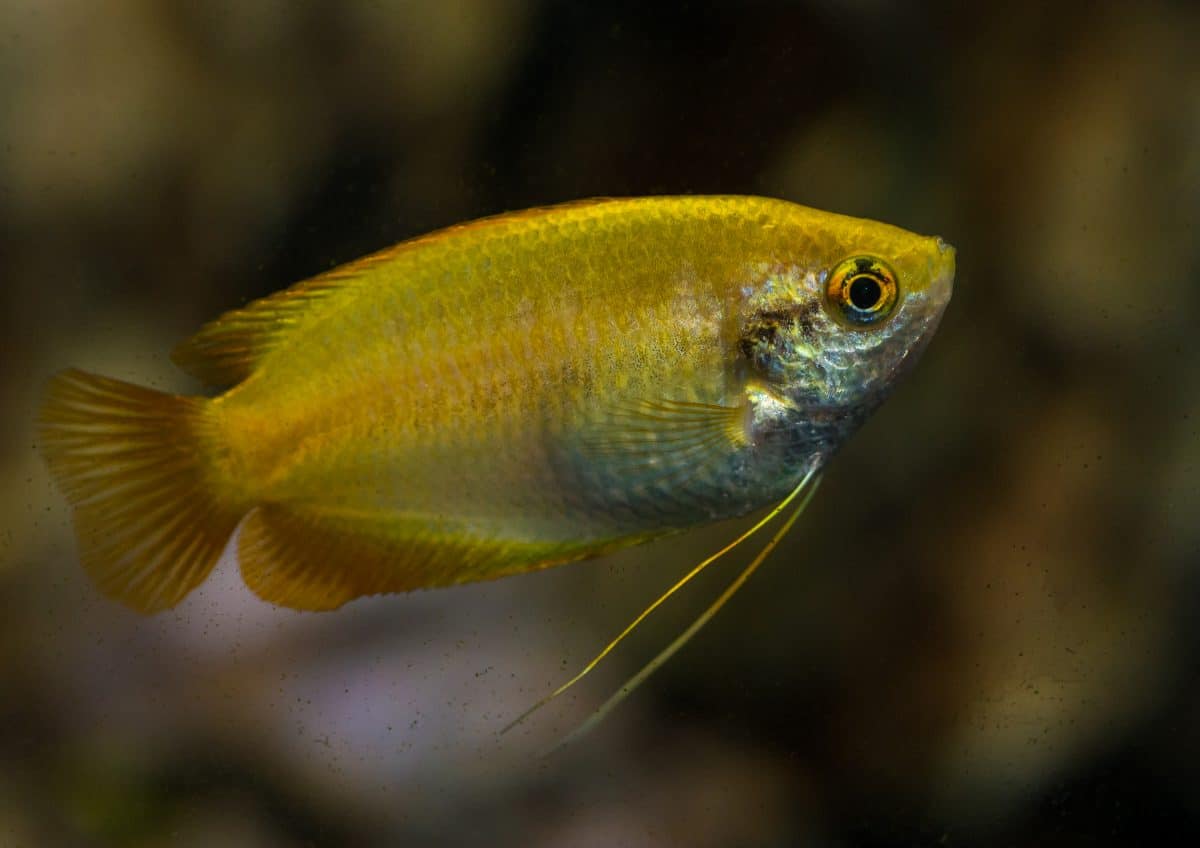
They have long dorsal fins across the length of the spine, which have a saw-like edge.
Underneath the chin are the ventral fins. These have a threadlike appearance with touch-sensitive cells which are used to sense their surroundings.
The anal fin is large, appearing as an extension of the caudal fin. The eyes may seem small in relation to their bodies.
Honey gouramis get their name from their color, although they change appearance slightly, depending on whether they’re spawning or not.
Normally, males are an ochre color, while the females are paler. When they’re spawning, though, male coloration will become more vibrant, and he develops a dark line which runs from the chin to the tailfin.
In the pet industry, gouramis can be found in orange, red and a silvery grey or black. However, these colors have been created through selective breeding and normally don’t occur in the wild.
They are a medium-sized fish, being between 1.5 and 2 inches in length. The fish has two “feelers,” which are surprisingly long, compared to the overall size. These project from the lower chin downwards.
In terms of telling male from female, the males are more vibrantly colored than females, especially when breeding. The females are typically slightly longer than the males.
Furthermore, males have sharper looking dorsal and anal fins, while females are more rounded. Males are generally slimmer than females.
Typical Behavior
Honey gourami are almost as vibrant in behavior as they can be in appearance. Unless they’re breeding, they tend to swim around the tank a lot. Because of their active behavior, they’re also fast swimmers, even when compared to smaller fish.
Generally, they will stick close to the top of the tank, as due them being a labyrinth fish they can and do need to occasionally breathe in oxygen from the surface. You will notice them swimming to the surface and gulping mouthfuls of air.
This air is passed into their respiratory system and eventually into the bloodstream. They don’t rely on air to survive or hold their breath when swimming. Instead, this behavior has evolved as a supplementary survival mechanism, which allows them to live in oxygen-deprived waters.
On top of this, they’re known to swim to the bottom of the tank when they’re looking for food.
They’re also fairly shy. As a result, you shouldn’t be concerned if they hide behind plants or other tank decorations, especially if they’re around large fish or in a new environment.
Most honey gouramis are peaceful, although they can be territorial when they’re breeding. They have very small teeth and may nip their tank mates in rare cases.
Habitat & Tank Requirements
Being native to the rivers and lakes of India and Bangladesh, they’re used to freshwater that has a mild to medium water flow. They’ve also been spotted in ponds, ditches, and flooded fields across both countries.
Furthermore, because of monsoons and flooding, they’ve been known to move through different areas during the seasons. Just like any breed of fish, their origins determine their tank requirements.
What Size Tank do Honey Gourami Need?
It’s recommended that there’s at least 10 gallons of water available per fish. It should also be noted that you must leave a gap at the top of the tank, as they instinctively swim to the surface, gulp air and take oxygen from it using their labyrinth organ.
Water Type & Parameters
Honey gourami are a type of freshwater fish. The best tank conditions for them would be 72–82 degrees Fahrenheit, have a “carbonate hardness” range of KH 4–10 and 6.0–7.5 pH.
Ideally, the room temperature that the tank is in would be quite close to the temperature of the tank itself. If not, you should employ the use of a tank heater to maintain this temperature.
What Substrate Should You Use?
They will settle within any common aquaria substrate you choose. This is due to the variety of materials they experience in the lakes, rivers, and ponds of their natural habitat.
That said, the best choice is often dark-colored gravel, simply because this is a great backdrop which allows their vibrant colors to shine through.
Filtration Requirements
Since they’re used to the naturally flowing water of rivers, honey gourami prefer a medium amount of water flow and currents within their tank.
The water should be kept clean and clear. You should invest in a high-quality filtration system, which enables adequate water flow to keep your fish in top form.
Lighting Requirements
Honey gourami aren’t too fussy with regard to lighting. All you need to be conscious of is whether or not the tank is situated, or lit, in a way which mimics natural daylight cycles.
Therefore, don’t leave the lights on bright overnight, or have the tank in a dark area of the room without lighting during the day.
Plants, Decorations, Swims & Open Spaces
As we’ve mentioned above, they can be pretty shy, so they need plenty of plants and rocks. It is also better if you have a mix of floating plants and ground plants, as they are happier with both in their environment.
That being said, though, your tank should still be large enough for them to have enough space for free swimming, no matter how many decorations you have.
How Many Honey Gourami Can You Have Per Gallon?
The widely recommended minimum is 10 gallons per fish. This allows them plenty of space to swim around without feeling overcrowded and becoming stressed. For every additional gourami introduced to the tank, another 10 gallons should be added.
Diet & Feeding
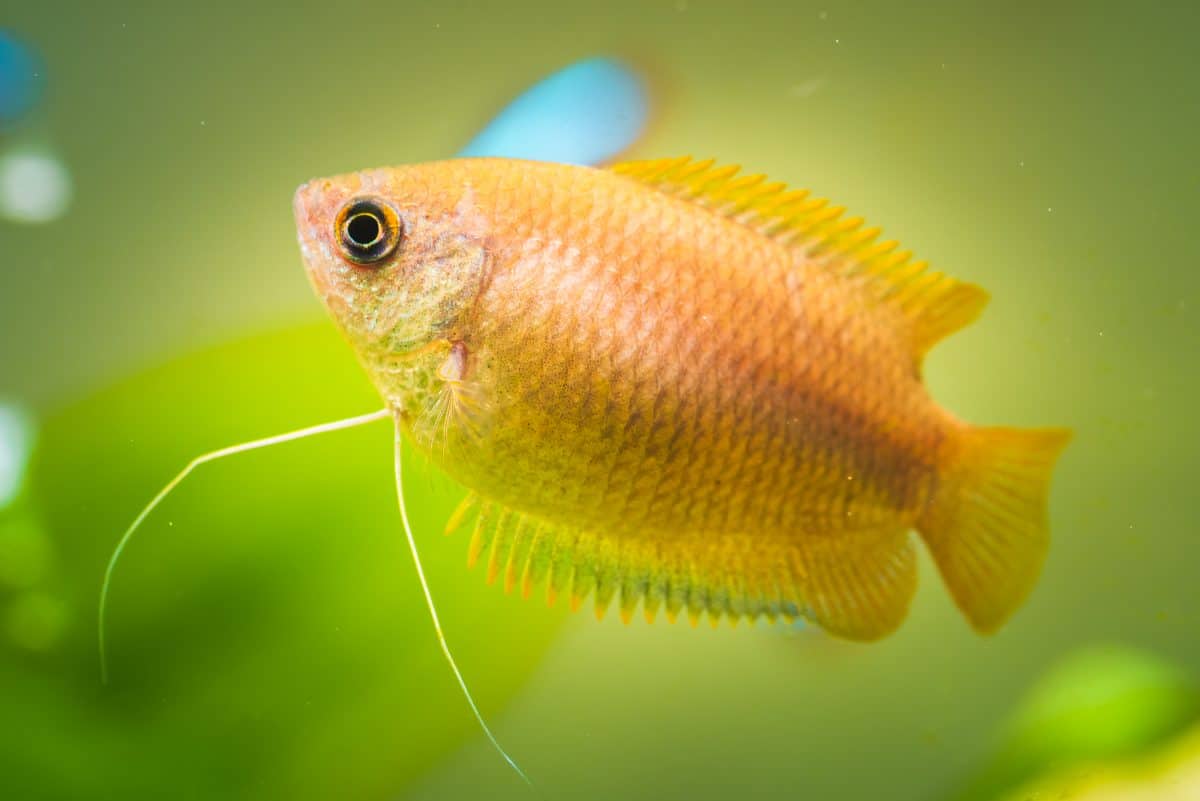
Honey gourami are omnivores, so they’ll eat both meat and vegetation. Of course, there is a bit of a difference between what they eat in the wild and what they’d normally have in a fish tank.
However, that doesn’t mean that they’re difficult to feed in a home aquarium!
What do They Eat in the Wild?
In their natural environment, they’ll eat small insects and larvae from the surface of the water, as well as algae growth found on aquatic plants.
What Can You Feed Them in a Home Aquarium?
They will eat a variety of easily available flaked food and freeze-dried food. However, it’s best to supplement that diet with worms or other small, live foods if you can.
What Human Foods Can They Eat?
Generally speaking, it’s best that they don’t eat too much human food. For a treat, you can try giving them finely chopped fruit, cooked peas or even shredded boiled cabbage.
How Often Should You Feed Them?
Normally, they should be fed twice a day. To avoid overfeeding, be sure to sprinkle the food bit by bit over a couple of minutes, so they eat gradually and don’t gorge themselves too quickly.
Any Special Care Requirements?
Outside of any care that we’ve already mentioned, there’s nothing special that you’ll need to consider. They are relaxed and easygoing fish that do not get upset easily.
Compatibility With Other Fish
They prefer to be in a tank with smaller fish as companions.
Great choices include betta fish, guppy, molly, swordtail, and neon tetra. Because of its peaceful nature, honey gourami should leave these smaller fish alone.
Can You Keep Multiple Honey Gourami Together?
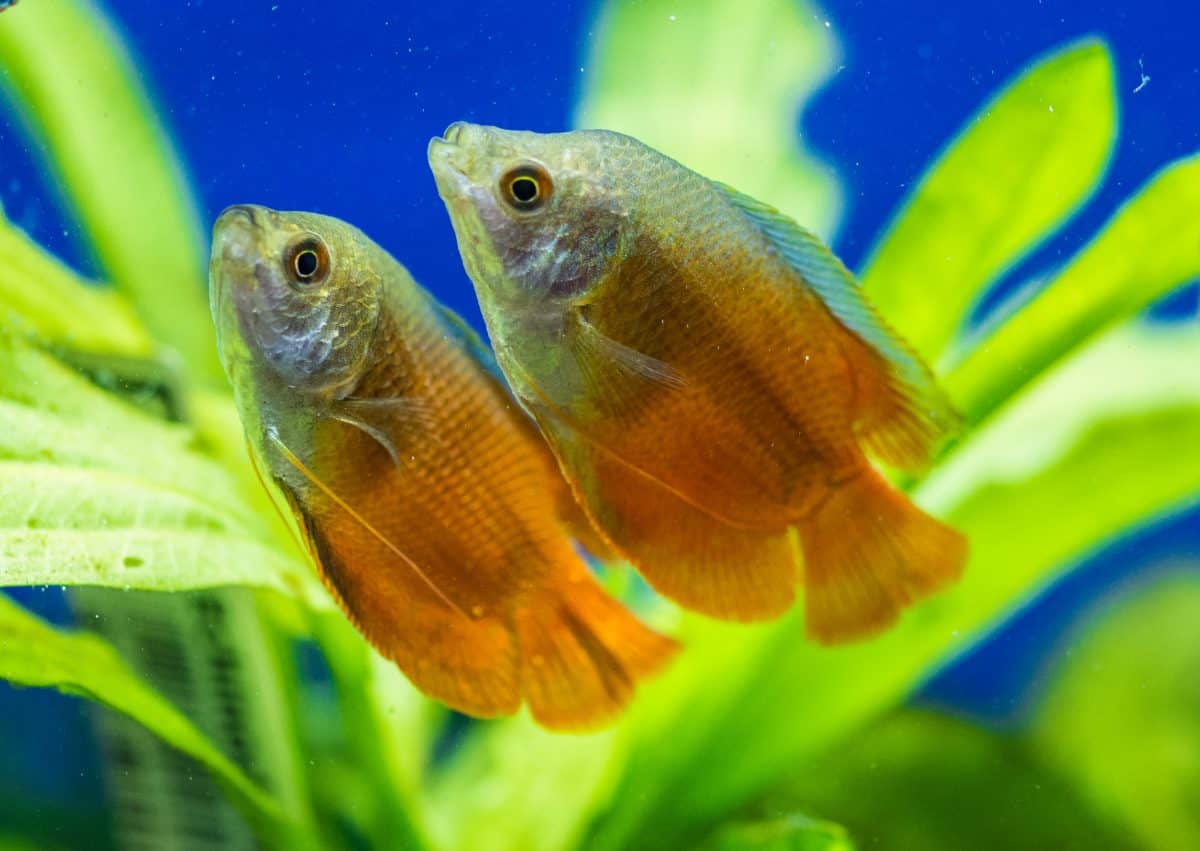
This is definitely a “yes,” although it’s slightly complicated. Essentially, you can keep one male with two females, or just one of each.
If there are two males, they can be known to attack each other to establish dominance, especially if they’re trying to get a female’s attention. You can keep as many females together as you’d like.
Despite only being a small fish, they do like to swim around a lot, which means they need a decent amount of space to swim comfortably.
Buying Advice
When you’re purchasing honey gouramis, you need to look out for any discoloration, roughness of the skin and scales, cloudiness in the eyes or unusual marks.
You’re also better off buying a younger (or several) fish, that will more easily adapt to your tank and become comfortable with any new tank mates.
Depending on the coloring, age, and some other minor factors, they will cost between $5 and $10. They are a commonly shipped breed, coping well with being transported.
When you’re buying one online, you should research the seller and read any reviews before buying, to ensure that your supplier is reputable and responsible.
Can you Breed Them?
In order to breed honey gourami, it’s important that you follow a few key steps to ensure everything goes successfully. First, you need to ensure that you’re feeding them live food, such as bloodworms, if possible. Failing that, any kind of high protein fish food will suffice.
The more they eat, the faster they’ll begin breeding. You’ll also need to make sure that you slowly raise the temperature of the tank up to 82 degrees Fahrenheit, which will help stimulate breeding behavior.
Once both fish are ready for breeding, the male will begin to change color slightly, in order to impress the female. His colors will usually deepen and intensify, so he looks much richer and vibrant than before.
Once the female has accepted the male as a mate, she’ll begin releasing eggs for the male to fertilize. She then leaves the nest and the eggs to the male, who will create a bubblenest in the vegetation for the eggs to develop in. These fertilized eggs should hatch between 24 and 36 hours later.
Once they’ve hatched, you should remove the fry to a juvenile tank and start doing daily water changes of about 10 percent. Be careful not to lower the water temperature in the process.
You should drip feed the fry infusoria by siphoning from a jar into the aquarium through an air-line hose. In contrast to more mature honey gourami, they need to be fed about five times a day in order to grow properly.
After about a week, you can introduce more solid food. The likes of brine shrimp are perfect for them, and this will help increase their growth rate slightly.
Summary
Honey gourami can make a rewarding and colorful choice of aquarium fish for intermediate fishkeepers.
Compared to many other vibrant fish, they don’t need much extra care or specialist equipment, save for leaving some air at the top of the tank for them to breathe.
With regard to tank setup, a single honey gourami can be kept in an absolute minimum of 5 gallons of water if necessary. But it’s generally accepted that a responsible fishkeeper will only keep one per 10 gallons.
Furthermore, while many pet fish can live just on flake food or pellets, it’s recommended that honey gourami have their diet supplemented with live food. This includes worms or brine shrimp, so that they’re nutrional needs are met.
This is especially true when they’re young, as the brine shrimp actively increase the growth rate of the fry during their early days.
Are there any honey gourami care tips that we missed? Do you have one and know something that might help prospective owners? Then why not leave a comment below and join in the conversation!
Happy fish keeping!

